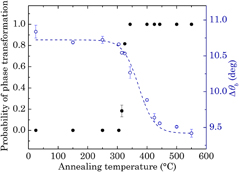Article contents
Correlation of indentation-induced phase transformations with the degree of relaxation of ion-implanted amorphous silicon
Published online by Cambridge University Press: 26 March 2013
Abstract

The probability for amorphous silicon (a-Si) to phase transform under indentation testing is statistically determined as a function of annealing temperature from the probability of a pop-out event occurring on the unloading curve. Raman microspectroscopy is used to confirm that the presence of a pop-out event during indentation is a clear signature that a-Si undergoes phase transformation. The probability for such a phase transformation increases with annealing temperature and reaches 100% at a temperature of 340 °C, a temperature well before the temperature where the average bond-angle distortion is fully minimized. This suggests that multiple processes are occurring during full relaxation.
- Type
- Articles
- Information
- Copyright
- Copyright © Materials Research Society 2013
References
REFERENCES
- 4
- Cited by


